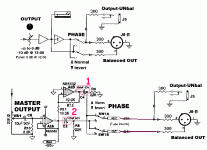There's my answer! Thanks.
By the way, I decided to go with four 2.2 uF Mundorf Supremes to try with no bypass caps, as an affordable cost upgrade option that also fits my circuit board real estate.
By the way, I decided to go with four 2.2 uF Mundorf Supremes to try with no bypass caps, as an affordable cost upgrade option that also fits my circuit board real estate.
Mundorfs have a good reputation.
One thing to look out for is lead diameter. Some times these audiophile caps have oversized lead diameters and don't always fit in the hole! This probably won't be an issue for you, but I thought that I would mention it. If it ends up being an issue just use a scrap lead to create an "adapter". What ever you do, do not drill out the hole... it will damage the solder pad.
One thing to look out for is lead diameter. Some times these audiophile caps have oversized lead diameters and don't always fit in the hole! This probably won't be an issue for you, but I thought that I would mention it. If it ends up being an issue just use a scrap lead to create an "adapter". What ever you do, do not drill out the hole... it will damage the solder pad.
Right. I was also considering Auricap XO 2.2 uF 400v capacitors, but each lead is comprised of a twisted pair of insulated multi-strand wires soldered together at the end, rather than a solid wire lead. I didn't see any wire diameter specs listed, and I was worried they might not fit the hole, so the Mundorf Supremes gained an advantage.
I thought that was clear, but now I am wondering why I don't have four caps for the balanced XLR outputs, and another two for the unbalanced RCA outputs, for a total of six! I guess they must tie in or split off from the XLR outputs somehow.There are two signal lines plus a ground for each channel of a balanced connection, so it requires four signal lines (and 4 cap) to make up a stereo pair. An RCA connection only has one signal line per channel, plus a ground, so only 2 caps for a stereo pair.
....I guess they must tie in or split off from the XLR outputs somehow.
Here is a snip from a good single-channel studio processor. The unbalanced (1/4") is just one side of the balanced (XLR).
Attachments
Last edited:
That example shown is the cheap electronic way of creating symmetric signals, but they are still referenced to earth. A true symmetical signal don't have this reference and is therefore better for blocking all disorders that can be coupled by earth. For this, a signal transformer is needed.
As this is the finer art of creating a symmetrical signal, only expensive equipment uses this way, because the transformers must be first class quality for not degrading the audio signal.Studio gear often uses transformer coupling.
As this is the finer art of creating a symmetrical signal, only expensive equipment uses this way, because the transformers must be first class quality for not degrading the audio signal.Studio gear often uses transformer coupling.
Sends can usually be "balanced", symmetrical to dirt. This will generally induce the least crosstalk to adjacent (generally groundy) circuits.
Returns will sometime be much better if "floating differential", NO reference to dirt. The problem here is that if some fool does not know to jumper an unbalanced signal correctly we get "no" signal (some treble bleed).
Modern studio gear avoids transformers except "for effect" or in very adverse situations.
Returns will sometime be much better if "floating differential", NO reference to dirt. The problem here is that if some fool does not know to jumper an unbalanced signal correctly we get "no" signal (some treble bleed).
Modern studio gear avoids transformers except "for effect" or in very adverse situations.
- Home
- Source & Line
- Analog Line Level
- How may coupling caps should there be?
